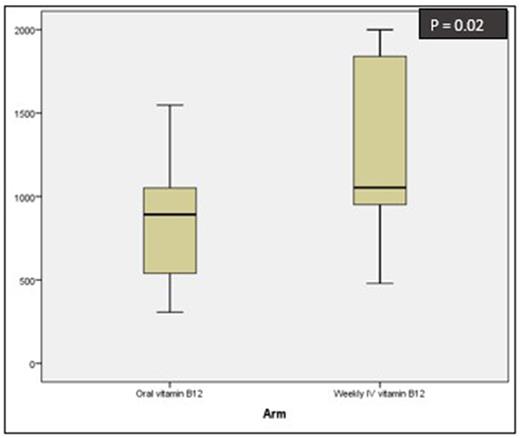Abstract
Introduction: The prevalence of symptomatic and asymptomatic Vitamin B12 deficiency is 47% in North India. The treatment for Vitamin B12 deficiency is either injectable or oral Vitamin B12 supplementation. Intramuscular VB12 is given as multiple doses of once daily or alternate day Vitamin B12 injections based on the general consensus. However, in hematology, we commonly use intravenous Vitamin B12 instead of intramuscular since most patients are thrombocytopenic. Many hematologists favor the oral route over injectable route. There are no definitive guidelines on the use of intravenous Vitamin B12 (VB12). Direct comparison of intravenous to oral VB12 has not been carried out till date. Hence, we decided to explore weekly dosing of intravenous VB12 in Vitamin B12 deficiency anemia and compare it with oral VB12 supplementation. It would be essential to seek evidence for the most effective route for the treatment of Vitamin B12 deficiency anemia.
Objectives: The primary objective was to evaluate Vitamin B12 level at 5 weeks from the start of therapy and the delta change in Vitamin B12 level in both weekly intravenous and oral VB12 arms. Post-therapy improvement in signs and symptoms, Hemoglobin (Hb), MCV (in fl) response were the secondary objectives.
Methodology: This was a prospective, randomized, open-label, interventional pilot study comparing daily oral versus weekly intravenous Vitamin B12 replacement at a tertiary care center between May 2020 to December 2021. Patients with anemia (for age and gender) and a pre-therapy vitamin B12 levels below 250 pg/ml were enrolled in the study. The participants were randomized using blocks of 2, 4 and 6 randomly generated by the software. The allocation concealment was done using sequentially numbered, opaque sealed envelopes (SNOSE) and monitored by the central coordinator. The participants in weekly intravenous arm received VB12 1000mcg intravenous (IV) once a week for 4 weeks whereas daily oral arm received oral VB12 1500mcg once a day for 4 weeks. All participants received 5mg Folic acid tablet orally once a day. The pre-specified baseline as well as post-therapy investigations were carried out. The statistical analysis was done as planned.
Results: Overall, majority of the participants were females (64.8%) and the a median age was 32 years (Q1-Q3, 21 to 52). The most common presenting symptoms were easy fatiguability (48%), hairfall (37%), and parasthesia (19%). On comparing the two groups, the pre-therapy mean Vitamin B12 level in the oral VB12 and weekly IV VB12 group was 157 ± 66 pg/ml and 173 ± 55 pg/ml (p=0.59) respectively and post-therapy mean Vitamin B12 level was 870 ± 348 and 1273 ± 511 (p=0.02) respectively. The post therapy VB12 level was statistically significant in weekly IV VB12 group, though the delta change in vitamin B12 level was not significant among the groups. The baseline hemoglobin in oral VB12 and weekly IV VB12 groups was 10.9 ± 1.3 g/dl and 10.5 ± 2.1 g/dl (p=0.5) respectively and the post-therapy Hb was 12.1 ± 1.3 g/dl and 12.3 ± 1.1 g/dl (p=0.7) respectively. The mean change in Hb was not significant on comparison between the two groups (p=0.65). The pre-therapy MCV in the oral VB12 group and weekly IV VB12 group was 86.5 ± 9.5 fl and 88.1 ± 17.9 fl (p=0.5) whereas post-therapy MCV was 83.1 ± 9.5 fl and 83.2 ±10.7 fl (p=0.9) respectively.
Conclusion: Normalization of vitamin B12 level was seen with both oral and intravenous vitamin B12, however, the weekly intravenous supplementation showed a statistically significant increase in vitamin B12 level than daily oral supplementation. Considering that the IV route provided a faster increase in vitamin B12 level, it could be a better option in patients with severe vitamin B12 deficiency anemia.
Disclosures
No relevant conflicts of interest to declare.
Author notes
Asterisk with author names denotes non-ASH members.


